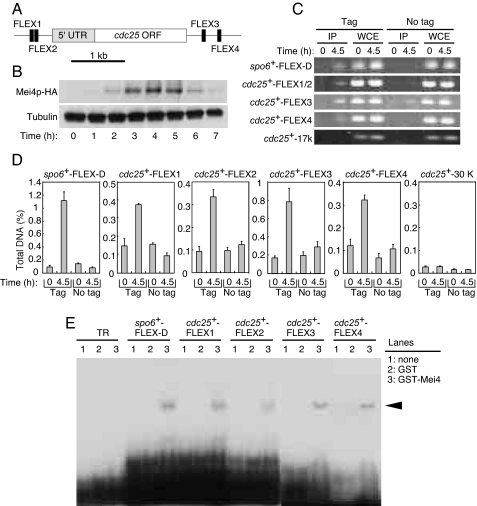Fig. 3.
Mei4p binds to the FLEX sequences adjacent to cdc25+ both in vivo and in vitro. (A) Schematic representation of the positions of FLEX sequences associated with cdc25+. UTR, putative untranslated region. (B) Cells expressing HA-tagged Mei4p (HM4832) were subjected to induction of meiosis as described in Fig. 1 and were subjected to immunoblot analysis with antibodies to HA at the indicated times thereafter. (C and D) A ChIP assay for FLEX sites associated with cdc25+ was performed with antibodies to HA at the indicated times after the induction of meiosis in cells expressing (tag, HM4832) or not expressing (no tag, HM1307) Mei4p-HA. The FLEX-D sequence of spo6+ was used as a positive control. cdc25+-17k or cdc25+-30k was ≈17 kb or ≈30 kb downstream of the start codon of cdc25+ and was used as a negative control. (C) After PCR, the samples were subjected to agarose gel electrophoresis. (D) Data represent the percentage of the target DNA precipitated with the antibodies and are means ± SE from at least three independent, quantitative, real-time PCR experiments. (E) EMSA analysis of cdc25+ FLEX sites with a recombinant GST-Mei4p fusion protein. Purified recombinant GST-Mei4p(71–182), GST, or buffer only (none) was incubated with the labeled oligonucleotide probes. A spo6+ FLEX-D probe was used as a positive control. The TR probe is unrelated to the FLEX sequence and was used as a negative control. Arrowheads indicate shifted bands.

